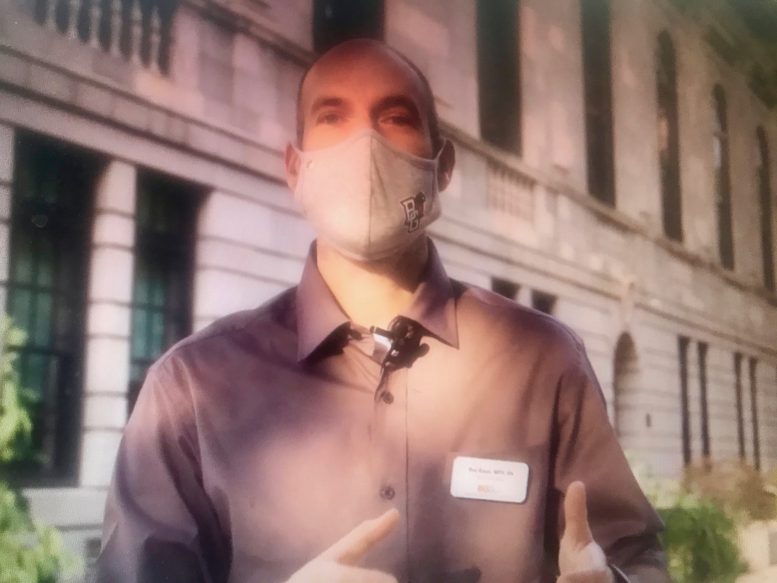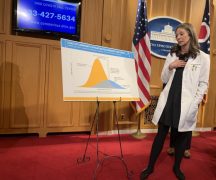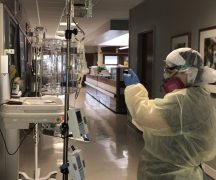By DAVID DUPONT
BG Independent News
When Ben Batey left his job as Wood County health commissioner to become chief health officer at Bowling Green State University, he said his intent was to continue to work with the health department and the local community.
That collaboration will bear fruit when high end testing lab is installed at the Wood County Hospital. “We’re actively ramping up testing capacity not just for the university, but also Bowling Green and Northwest Ohio,” Batey said in a telephone interview Friday.
The university and hospital worked to purchase the expensive equipment, which Batey said he hopes can be ready to go, after installation and training, in about a month. “We’re trying to do this in as quick a time frame as possible,” he said.
The PCR test “is the gold standard right now.”
The testing will be done by hospital personnel and university personnel who work in lab environments.
This will allow for a large number of tests to be done, and to determine the results without shipping them across the state.
Results should be available, Batey said, in two or three days, maybe even the same day in some situations.
The goal would be a capacity of 500 tests a week, not just for the university, but for the community at large.
That number, Batey said, will give the data needed to monitor the spread of the coronavirus without “over utilizing that scarce resource.”
The university opted to open without a massive testing effort. Some schools that are engaging in face-to-face instruction tested thousands of students, faculty, and staff weekly.
If BGSU decided to drastically increase its testing that would put a strain on the number of tests, Batey said, and increase the lag time in getting results. “From a public health perspective that didn’t seem the best use of that resource,” Batey said.
BGSU has been doing surveillance testing since before the semester began and will continue to test those who exhibit symptoms as well as “strategic testing of different random groups” of faculty, students, and staff.
They want to make sure they have tests available if an outbreak occurs they can respond quickly and get people into quarantine.
Once the testing in up and running at the hospital that will speed up the process, so someone who has been in contact with someone with COVID-19 may only have to be quarantined for a few days while waiting for tests to return.
On Wednesday, Batey released the first weekly COVID-19 updates that showed from 351 tests done before the semester started, only five were positive, a 1.5 percent prevalence rate.
Batey said a number of factors played into the decision of whether to open for some face-to-face instruction, albeit in a limited and altered way, or to be all remote.
Part of the decision, he said, was “the recognition Bowling Green is a college town.”
“Whether we had in-person college classes or whether we were fully remote, the students were going be in Bowling Green.”
Many consider this their home during the school year. “They were going to be here regardless.”
The university could have just abdicated and left it up to the county health board and the community to deal with the influx.
“We felt we had to be on the frontlines,” he said, and do what the university has always done and work in collaboration with the community.
Also, “there’s definitely a feeling at the university that education is an essential service,” Batey said. “We can’t shift to remote for all aspects of it.”
He knows from his own background in nursing how essential hands-on lab work and interaction with patients is.
The aviation program is another example. “I would not want to have a flight with a pilot who learned how to fly through Zoom.”
He will be monitoring a number of factors – how many people are seeking treatment of symptoms, how many are testing positive, how many students are in quarantine, how many are in isolation.
The county health department has built up a contact tracing team, and the university is in the process of developing its own. That’s necessary to find how many people have been in contact with someone who tests positive.
Those who have been will be quarantined in their housing until they get their test results back. Those who are positive will be in isolation at the university’s Falcon Pointe residence hall.
If the virus becomes widespread at the university, though, students will not be sent home, Batey said.
The situation is very different than it was five and half months ago. “In the spring when the university shut down and the students were sent home, there were a lot of unknowns about this virus,” Batey said. Public health officials didn’t know how widespread it was in the population. The health care system hadn’t seen anything like this, so doctors didn’t have a way to treat it or how long a patient could be contagious, or how fast it could spread. So, the decision to “shelter at home until we can figure this thing out” was the wisest course.
Now treatment options are emerging, and public health officials have more information on how it spreads.
Just sending students home if there is an outbreak on campus may not be for the best. That would amount to shifting the risk onto someone else, Batey said.
Students will have the option to return home.
“We would want to make sure we’re working with all students to make the best decisions for themselves and their families to keep the risk level low for all people.”
In that instance the university would have to dial back face-to-face activities, but it wouldn’t result in the whole campus coming to a stop.
Asked what makes him optimistic, Batey said that even though the numbers show some community spread the numbers of those hospitalized have not gone up, and there’s not been pressure on the availability of hospital beds nor room in intensive care units.
“Demand on the health care system at Wood County Hospital and from Mercy Perrysburg has been extremely low,” he said. That was not the case in the early days of the pandemic.
“Every day the hospitals and the health system are figuring out how to better treat people impacted by this virus,” he said.
Increased knowledge about how the virus spreads allows for mitigation protocols, such as face covering and social distancing to be implemented. Those protocols make it possible for someone to come to campus, “but feel their risk level is as low as it can be.”
People can still socialize, but not in such close proximity. With the “drastic de-densification” of campus and allowing some people to work remotely, it will minimize those interactions.
When asked what makes him pessimistic, he responded: “I feel we have created a great system across campus to slow down the spread. But when people step foot off campus we no longer have that system in place. When they go off campus, it becomes personal responsibility.”
Campus officials can do all they can to let students know their actions will in large part determine whether BGSU can have a successful semester, and that their actions affect not only themselves, but other students as well.
“We can’t have large parties off campus,” Batey said. “We know this is where large outbreaks come from.”
University officials are working with the city, police, and landlords to get that message out and enforced it.
“These activities will not be tolerated.”





